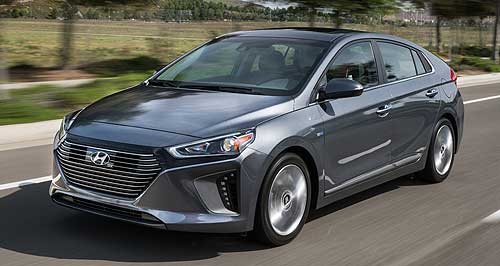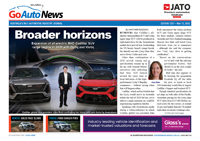News - HyundaiParis show: Hyundai covers all the ‘green’ basesPower up: Hyundai’s Ioniq has been engineered to take hybrid, plug-in hybrid and all-electric powertrains under Hyundai’s strategy to cover the alternative energy bases. 26 environmental powertrain variants to drive Hyundai cars of the future3 Oct 2016 By RON HAMMERTON in PARIS HYUNDAI is planning no fewer than 26 green-vehicle powertrain variations for its new models around the world within four years. Hybrid, plug-in hybrid, all-electric, hydrogen fuel-cell and bio-ethanol powertrains are covered in the list, with several variations of most of these to cater for different types and sizes of vehicles in different markets. The company says the approach is necessary because of differing needs and preferences in markets around the world, with some countries favouring electric cars, others encouraging hybrids, a few chasing a hydrogen future and others, such as Brazil, locked into ethanol. Some countries simply do not have the infrastructure for mass adoption of plug-in vehicles, it says. The approach is in sharp contrast to rival Volkswagen whose chairman, Herbert Diess, said when launching the company’s upcoming ID electric car at the Paris show this week that his company planned to ultimately go all-electric, with no plug-in hybrid or internal combustion powertrains. Hyundai Motor Europe’s head of fuel-cell vehicles, Frank Meijer, told GoAuto that Hyundai believed that to aim for one type of powertrain was the wrong direction. “From a German perspective, it (EVs) makes quite a lot of sense because there is a tremendous amount of renewables that are not being used,” he said. “We are a global company, one of the largest OEMs in the world, so we also have China, the Middle East, South America and other regions to think of. “The regional demands will differ a lot. In South America, it is much more on bio-ethanol and mixtures of fuels, in China we see a huge amount of electric, and in Europe it might be hydrogen. “I think it is very wrong at this moment to bet on a particular powertrain because the demand globally will have a huge spread.” Mr Meijer said the number of alternative powertrains to cover all these requirements would number 26 within four years – “a massive amount of different powertrains”. He said one of these would be fitted to a new electric car to be launched next year. This vehicle will join Hyundai’s existing electrified vehicle, the Ioniq, that will come with three powertrains – hybrid, plug-in hybrid and all electric. “Of course, everything is around this electric powertain, even fuel-cell. It still uses electric battery, it still uses electric motors. It is the same with hybrid. Of course, electrification is the centre.” Hyundai is pioneering sales of hydrogen fuel-cell vehicles in some markets, with its ix35-based FCEV achieving 300 sales in Europe so far. Many of these vehicles are taxis, in France, Netherlands and Norway, where they are taking the hydrogen message to the public. In Paris, the Hyundai FCEV taxi fleet is expected to grow to 70 by the middle of next year, with each operating two shifts a day, covering up to 500km of urban slog and only requiring refuelling at the end of each shift. As GoAuto has reported, Hyundai is developing an all-new hydrogen fuel-cell car on a dedicated new platform. Due for launch in 2018, the car’s engineers are aiming for a driving range of 800km – 200km more than the official European NEDC combined test result for the current car. Mr Meijer would not be drawn on the technology or performance targets planned for the new vehicle, but said all of the current vehicles’ figures – 100kW maximum power, 160km/h top speed and 600km range – could be expected to be exceeded by the new model. “More importantly, we expect the interior to make a huge leap due to dedicated technology,” he said. While the current FCEV has two different size carbon-fibre hydrogen tanks to achieve the required 144-litre volume within a conventional chassis, the new car’s design is expected to provide for two or three uniform tanks for a more affordable, compact layout. This frees up room in the cabin.  Read more |
Click to shareHyundai articlesResearch Hyundai Motor industry news |

















Facebook Twitter Instagram